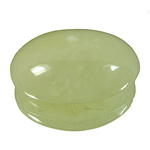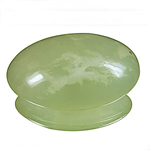Bowenite
A variety of the mineral antigorite, which belongs to the serpentine group.
The serpentine group encompasses 20 minerals and their varieties.
Best known is the fibrous chrysotile asbestos, which was used as a building material until the 1990ies before it was found to be carcinogenic.
All other members of the serpentine group are non-fibrous and do not pose any health risk.


Origin of name: the name serpentine derives from the latin word for snake, serpens, and probably refres to the snake-like patterns of some group members.
Antigorite was named after the type locality, the Italian Valle di Antigorio, in the Piemont.
Bowenite was named in 1850 by James Dwight Dana, the famed geologist, mineralogist and taxonomist, after George Thomas Bowen, a chemist and mineralogist at the University of Nashville, Tennessee.
Synonyms and trade names: yellow bownite is sometimes called retinalite.
Bowenite from New Zealand is traded under the name of tangiwai.
Can be confused with: the jade minerals nephrite and jadeite as well as with other members of the serpentine group. The distinction of bowenite (antigorite) from the jade minerals poses no great problem for the gemmologist and can be achieved by measuring the specific gravity (bowenite/antigorite 2.6, nephrite 3.0, jadeite 3.3)
Localities: the oldest known deposits are probably the ones on New Zealand´s South Island, in the area of the Ngāi Tahu people. The deposits are protected by law and may only be worked by the Ngāi Tahu or with their permission.
Important sources are located in the east of the United States (Rhode Island, Maine, Massachusetts, Pennsylvania, New York and Vermont).
In 1989 a sizeable deposit was reportedly discovered in South Africa.
Other sources are China, Pakistan and allegedly Afghanistan.
Handling: due to the low hardness, the brittleness and the very good cleavage, the use of bowenite in jewellery is quite limited. We strongly advise against wearing it as a ringstone.
Worth Knowing: bowenite is the state mineral of Rhode Island.
 Deutsch
Deutsch